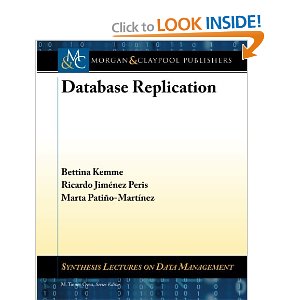Database Replication
 Book Description
Book Description
Database replication is widely used for fault-tolerance, scalability and performance. The failure of one database replica does not stop the system from working as available replicas can take over the tasks of the failed replica. Scalability can be achieved by distributing the load across all replicas, and adding new replicas should the load increase. Finally, database replication can provide fast local access, even if clients are geographically distributed clients, if data copies are located close to clients. Despite its advantages, replication is not a straightforward technique to apply, and there are many hurdles to overcome. At the forefront is replica control: assuring that data copies remain consistent when updates occur.
There exist many alternatives in regard to where updates can occur and when changes are propagated to data copies, how changes are applied, where the replication tool is located, etc. A particular challenge is to combine replica control with transaction management as it requires several operations to be treated as a single logical unit, and it provides atomicity, consistency, isolation and durability across the replicated system. The book provides a categorization of replica control mechanisms, presents several replica and concurrency control mechanisms in detail, and discusses many of the issues that arise when such solutions need to be implemented within or on top of relational database systems.
Table of Contents:
Overview / 1-Copy-Equivalence and Consistency / Basic Protocols / Replication Architecture / The Scalability of Replication / Eager Replication and 1-Copy-Serializability / 1-Copy-Snapshot Isolation / Lazy Replication / Self-Configuration and Elasticity / Other Aspects of Replication
Book Details
Paperback: 154 pages
Publisher: Morgan and Claypool Publishers (September, 2010)
Language: English
ISBN-10: 1608453812
ISBN-13: 978-1608453818
File Size: 1.8 MiB
[下载地址]